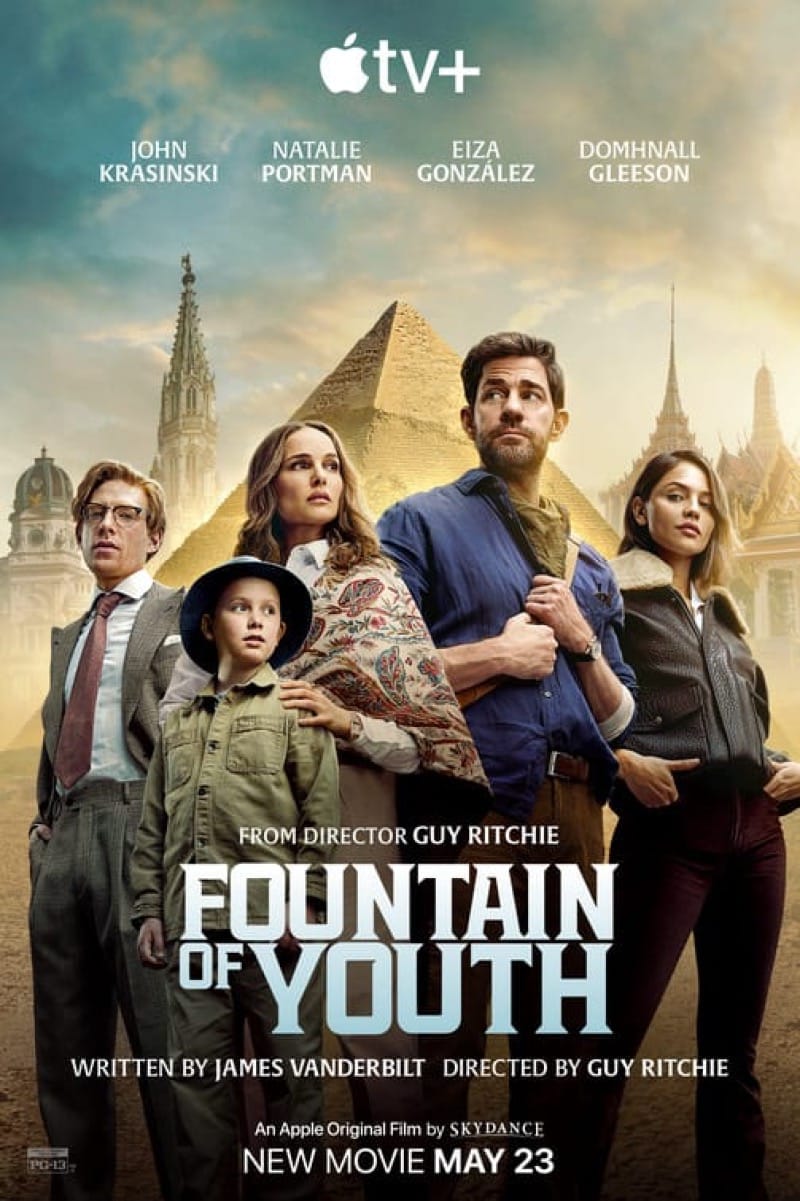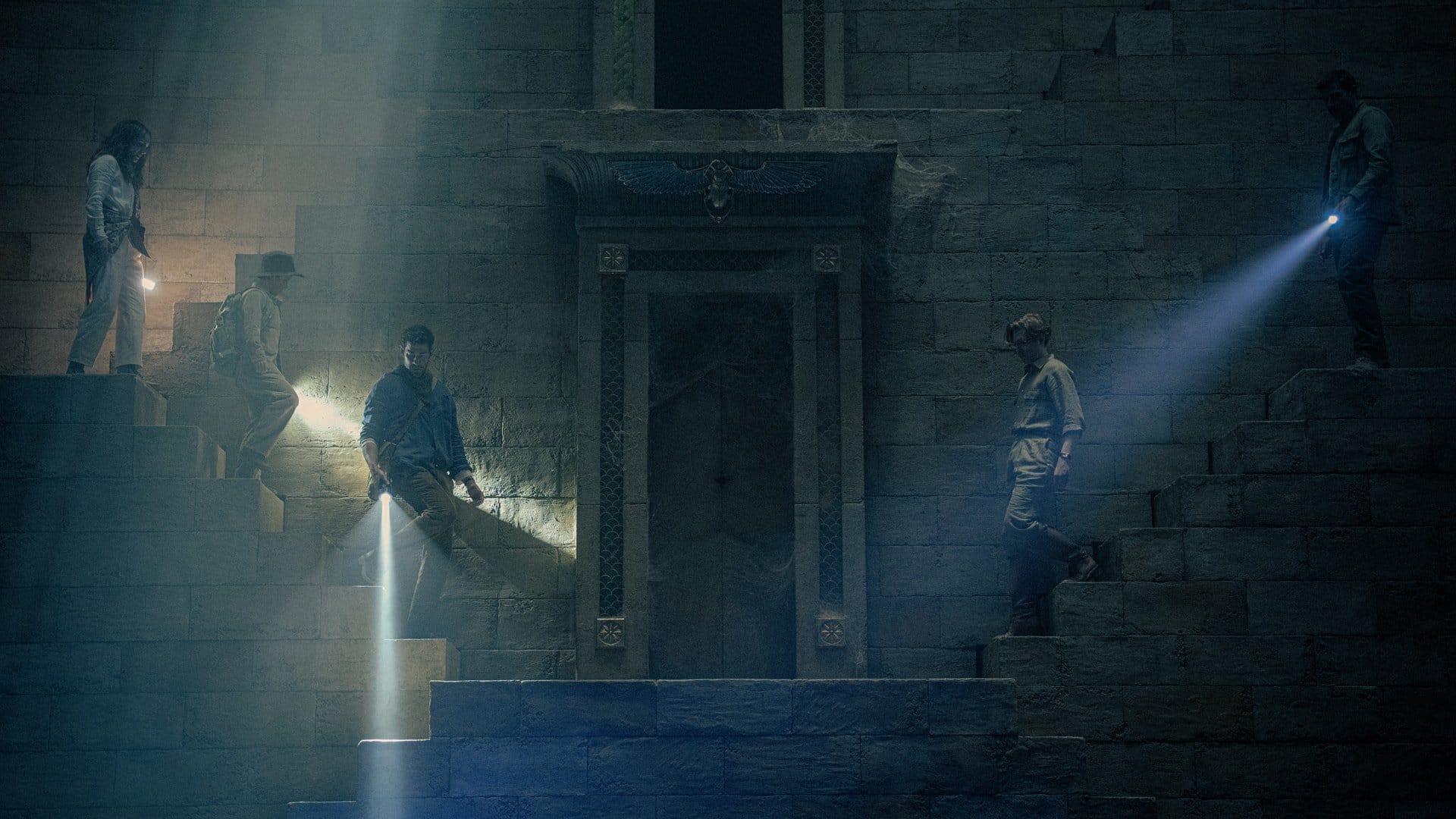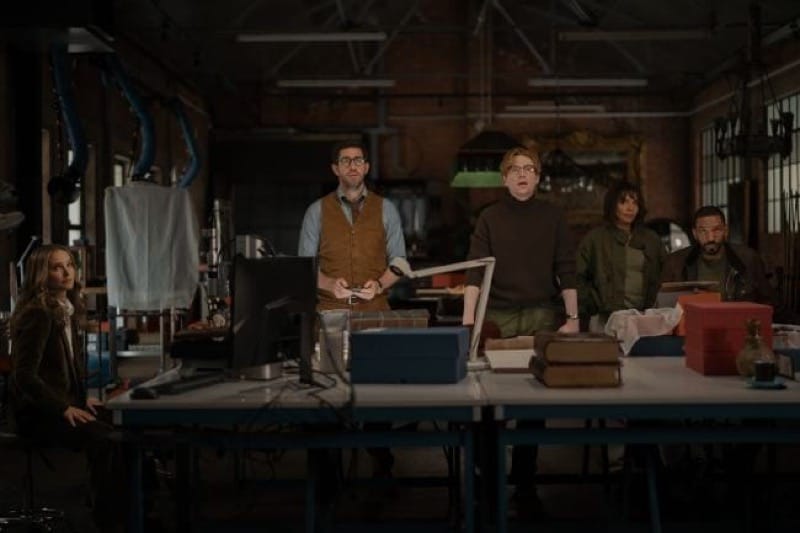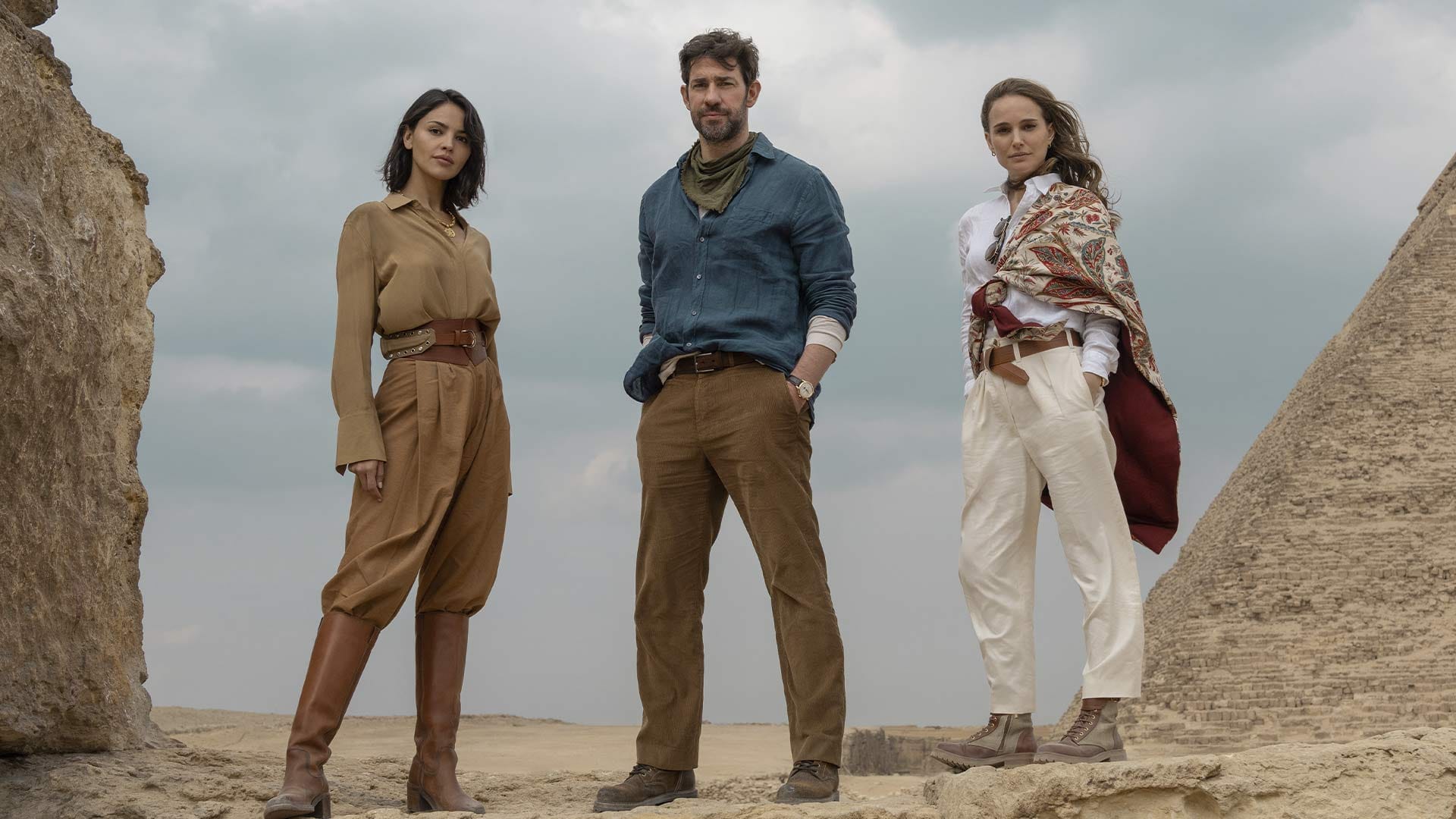Fountain of Youth
Perfect for falling asleep to.

Having once been a close family of globe-trotting adventurers, explorers, and "obtainers of rare antiquities," two now-estranged siblings find themselves on a dangerous quest, following clues that have been hidden throughout history, all supposedly leading to the Fountain of Youth.

In Hollywood’s continued fevered search for a new style of tentpole blockbuster movie that will take the crown from the now aged head of the superhero film, they have turned once again to a beloved old hat… a fedora, specifically, as they offer us this uninspired retread of better movies, Fountain of Youth.
Featuring fanfic versions of the children of Indiana Jones—known here as Harrison Purdue, because Harrison Ford played Indiana Jones, and Perdue is a university in Indiana—Luke and Charlotte Purdue are on a wild, world-wide hunt through some well-trod mysteries of the past, uncovering a plethora of long-buried secrets, despite the fact that those secrets all seem to be visible to the casual eye, in much the same way the movie National Treasure did, except in this film, the focus is on global history, instead of American history. National Treasure, of course, was only walking the same path that the 1999 movie, The Mummy, had already walked, except it used more modern history, instead of ancient. The Mummy, meanwhile, was only ever a cheaper version of Raiders of the Lost Ark, which is vastly superior to all of these movies, and the one that established the formula its ungainly bastard children have all dutifully followed ever since. The main difference when it comes to Fountain of Youth is, instead of the man and woman leads being lovers, they’re siblings here, albeit with the same bickering and quipping energy.
In short, Fountain of Youth is just a copy of a copy of a copy, and the results have long since grown faded and blurry. All-around poorly-executed, but with a decent core idea, it tells that old and familiar tale centered on the belief that ancient civilizations would have looooved the game Mousetrap. It is a celebration of grave-robbing, wordle, and some impressively-engineered ancient architecture, all directed by Guy Ritchie, the most unexciting d-tier ripoff director still inexplicably getting regular work in the year 2025, and right away, my very first question was:
Was the inclusion of a Thai version of the song Bang, Bang (My Baby Shot Me Down) as the opening of the film deliberately intended to remind us that, before he was ripping off Turteltaub, Sommers, and Spielberg, Guy Ritchie made his bones ripping off Tarantino…?
Or was that just an accident?
Still, all that having been said, if I’m being honest here, going into this film… I kind of had some high hopes. I’m a sucker for Indiana Jones, after all, even the dollar store version. So, despite my fairly reasonable expectations otherwise, I still hoped that it would be fun. Like I said, the core idea, the hunt for the Fountain of Youth?
That’s a potentially good McGuffin.

The Fountain of Youth is a mythical spring, or sometimes a river, or maybe a well, that restores the youth and vitality of those who drink or bathe in its waters, and possibly even bestows the gift of eternal life.
The stories of such a wonder can be found all throughout history. In the 5th century BCE, Herodotus, the historian and geographer—often known as The Father of History, and occasionally as The Father of Lies—mentions such a fountain in the land of Macrobians. A legendary place believed to be located in the Horn of Africa, it was said there was a tribe of flesh-eaters and milk-drinkers there who all lived to be well over a hundred, and all because they bathed in a strange fountain. In the 3rd century CE, Alexander the Great supposedly journeyed through “The Land of Darkness,” a place supposedly enshrouded in perpetual darkness, which may have been modern day Abkhazia on the eastern coast of the Black Sea, all because the fountain was rumored to be located there. In the 1300s, an alleged travel memoir, known as The Travels of Sir John Mandeville, claimed the fountain was located at the foot of a mountain outside Kollam, India. In the 1500s, the Spanish explorers heard legends of Bimini, a land of wealth and prosperity, and those stories claimed that a “Healing Hole” lied within a salt water mangrove swamp along its shoreline. And while there’s no actual historical evidence of this, finding the land of Bimini is said to be why King Ferdinand II of Aragon sent conquistador Juan Ponce de Leon on the first known European expedition in 1513 to the strange and dangerous land that Ponce de Leon would eventually dub as… Florida.
Like Solomon’s Seal, like the Spear of Destiny, like the Holy Grail, like the Philosopher’s Stone, the Fountain of Youth has long been one of the Great Prizes. A thing men quested for, and killed for, and never found, mostly because these quests are for fictional objects, but also because, at least from a narrative point of view, it was more about the promise of a treasure beyond measure, of the chance of finding something greater than ourselves, of the tantalizing dawn just beyond the horizon, about gaining knowledge, and a peek behind the curtain, they're journeys of self-discovery and transformation, more then they are about any actual object. Although, actually finding one of them would've been cool too. In short... It's about fortune and glory, kid. Fortune and glory.
This movie does not deliver on that promise.

After disgraced archeologist Luke Purdue barely escapes Thailand with a stolen painting that both a criminal gang, and a mysterious and incredibly sexy woman named Esme and her commando team both want, he heads to London. In London, Luke’s younger sister Charlotte is beset with divorce and custody issues, as her life of sedate mediocrity is crumbling, and the weight of her hum-drum existence as a museum curator threatens to crush her spirit. Luke surprises her at the museum, and before she can puzzle out why, he loops her in on a suddenly wacky art theft of Rembrandt’s Head of Christ.
But as Luke explains to Charlotte as they careen through the streets of London in a rather unexciting high speed chase, he’s not an art thief, he’s actually on the trail of one of the greatest mysteries in the history of mankind. Charlotte is dubious, but at Luke's hideout, she meets brother's team. There’s Murphy something, who handles transportation and logistics, and Deb whatsherface, who handles the research and the explosives, and then there’s Owen Carver, the deep pockets, a billionaire who is financing the whole endeavor, and that endeavor is... the hunt for the Fountain of Youth. But why? Why are they chase a myth?
Again... Fortune and glory, kid. Fortune and Glory.

Also because Owen Carver is dying.
Besides the Thai Crime Family they robbed, as well as the Interpol agents hot on their trail, standing in their way is a secret society known as the Protectors of the Path, who have been working to keep the true location of the Fountain secret for centuries, and they are willing to kill to maintain that secret. Luckily for Luke and Charlotte, a rebel faction of famous and thoroughly studied artists, who were once a part of the Protectors of the Path, disagreed with that mission, and so they arranged for clues to be hidden in six of their very famous paintings… El Greco's Christ Carrying the Cross, Ruben's The Descent from the Cross, Caravaggio’s The Taking of Christ, Wilden’s Christ and Disciples on the Road to Emmaus, Velázquez’s Christ Crucified, and the last one... Rembrandt's Head of Christ.
Unfortunately, while the Rembrandt isn’t a fake, it’s just not the version of it. So they’re off to raise the wreckage of the Lusitania, the oceanliner that was famously sunk by a German Uboat in 1915, paving the way for the U.S. to enter WW1, because the real painting went down with its owner and the ship. Soon enough, Luke and Charlotte are raising the wreckage, cracking a safe that’s been underwater for over a century, and fighting commandos and that sexy lady again, all while the Lusitania re-sinks.
Back in London, the team figures out that the letters written in plain site on the paintings spell out “Wicked” but not for why you’d assume. It’s actually referring to the Wicked Bible, sometimes called the Adulterous Bible, or the Sinners' Bible, a printing of the King James Bible from 1631 that had some mistakes in the copy, chiefly in the Ten Commandments in Exodus 20:14, where the word "not" was omitted from the sentence, "Thou shalt not commit adultery.”
But then their hideout is raided by both Interpol officers, under the command of Inspector Jamal Abbas, as well as by that Thai Crime Family that Luke ripped off in the beginning of the film. There’s shooting and running and barely getting away, and after picking up musical prodigy Thomas, Charlotte’s young son, for reasons, they head to the Austrian National Library. Esme shows up with her commandos soon after, and now Luke and Charlotte must steal the Wicked Bible all while an entire new scene of running and shooting happens.
At their hotel, they are unable to decipher the clue in the wicked Bible, and Charlotte has a denial of the call moment, angrily stomping out of the hotel with her kid in tow, before almost immediately returning, because Thomas is a musical prodigy, so he recognized what the clue really was long after the audience already had, but well before the rest of the characters. The clue is actually musical notes. By playing the sequence, Murphy identifies it as an ancient song called “Water in the Desert“ that honors the Seven Wonders of the Ancient World—The Lighthouse at Alexandria, The Colossus of Rhodes, The Temple of Artemis at Ephesus, The Hanging Gardens of Babylon, The Statue of Zeus at Olympia, and the Mausoleum at Halicarnassus, which was the last surviving of the fallen Wonders, all of which have now been destroyed by earthquake, fire, or man.
The only Wonder that is still standing is the Great Pyramid of Giza.

So that’s where we go next, and the camera does an excellent job of maintaining the grandeur of the last remaining Wonder of the Ancient World by only shooting it from angles that hide the nearby Pizza Hut.
While Owen Carver leaves a large company of shockingly heavily armed mercenaries in the middle of a modern city, Luke and Charlotte and Thomas and Owen enter the pyramid, knock down a wall of two, play a song on some ancient bongos, descend a few hidden staircases, and Badda-bing-badda-boom… they find the Fountain of Youth. Esme shows up, as does as Interpol. Bullets and fists fly as magic is proved to be real, and in the end, it turns out that Fountain of Youth was long hidden for a reason, as it is both a blessing… and a curse.
When it’s all said and done, the Egyptian authorities apparently didn’t notice the sustained 50 caliber gunfire from multiple M2 Brownings, nor did they notice the exploding vehicles and whatnot that is happening in front of one of their greatest national treasures, so they neither seem to show up nor complain. No blood, no foul, I guess.
And thus, our heroes walk away, laughing and hugging, and chatting happily about exactly which mystical item the Perdue family will hunt down next…

Fountain of Youth is an obvious and dull movie that it presented in the most obvious and dull way. Overly long, but somehow still feeling like it was chopped up in editing due to too many reshoots, it’s the type of movie where it turns out… (gasp) the billionaire has ulterior motives, and guess what kids, they're not only not very altruistic, but in fact, they're very selfish and driven solely by greedy capitalism! What? Someone get me my fainting couch!
James Vanderbilt wrote Rundown and Zodiac, both of which I really enjoyed, but he also wrote The Losers, The Amazing Spider-man, The Amazing Spider-man 2, and Independence Day: Resurgence, and unfortunately, after watching this film, I think it's fair to say that the latter are much more indicative of his talent than the former are. The best part of this film is the bit of trivia that the screenwriter's paternal great-grandfather, Alfred Quinn Vanderbilt, Sr. actually did go down on the Lusitania, and not in the fun way either. He uses this fact as a plot point in the story too. And I will admit that I do love when you can clearly see a writer is finally getting to use a little tidbit/detail that they’ve been keeping in their pocket forever, and now finally have the chance to shoehorn it into something. But otherwise, this film is not only dully shot, but it is absolutely filled with the clunkiest and the most awkward of clunky and awkward exposition. One of the most convenient parts of visiting Japan, I found, was the fact that, if you just waited a moment, the digital signs would all switch to English. This was really helpful if you didn’t speak the language, but when a similar idea is applied to a movie script, all you get is the characters explaining everything, at great length, over and over.
It's tedious.
Fountain of Youth has all the pieces of a fun movie, but just… none of the fun. For a film all about the hunt for eternal life, life is exactly what it lacks.
Some people like to complain that superhero movies have blocked all these great original IP films from being made, but the reality is, this movie, Fountain of Youth, this is the exact type of film that we lost, these big name, blandly innocuous, "fun for the whole family," vaguely sketched out, big tentpole brouhahas are all that the superhero genre has seemed to replace. And worst of all, the fact that these films are still being made, and are still playing, shows that, the unfortunate reality is, we haven’t actually lost them either. In fact, the only thing that's changed is they no longer play in theatres. Is that bad? I don't think so. Especially since it means that these supposed blockbuster no longer force their trailers on us, over and over again for months before their summer release, only for them to then open huge on the first weekend, and then crash the next, as word of mouth gets around that it’s actually a terrible movie.
Really, all that’s changed is these one-off, lifeless garbage films, like Electric State, Red One, Salem’s Lot, or Spenser Confidential (I bet you forgot that piece of shit was even made!), all these "big name action extravaganza" films that used to dominate the multiplexs every summer and holiday, are now much more easily forgettable as they languish on one streamer or another before fading away. The only truly sad part about that, is the way Hollywood has finally managed to cut out the middle man, wiping out all the video stores and retail markets now, which means they are denying films like this the musty Valhalla that was once theirs, the racks upon racks of forgotten and ill-conceived Hollywood blockbusters that was to be their last resting place, were they would all wait together, sun-faded and dusty, to perhaps one day be happened across, and rented on some random friday night.
But I digress...
I will say that I’m interested in the future of this franchise, because as the heroes are walking away, discussing what the next mysterious item of antiquity they will try to find next, Thomas turns to his mom and uncle, and excitedly says, “I’ve got an idea!” And then “Wonderwall” by Oasis plays as the credits roll.
And I wondered... was this a hint?
Will the potential Part Two be much more of a journey into the dark night of the soul, a hunt to find the thing that will finally heal the rift between Liam and Noel Gallagher, and thus, reunite Oasis…? Which begs the question, will the world be able handle the full celestial power of such a reunification, or are some things better left as they are...?
Find out in Fountain of Youth 2: Champagne Supernova!

